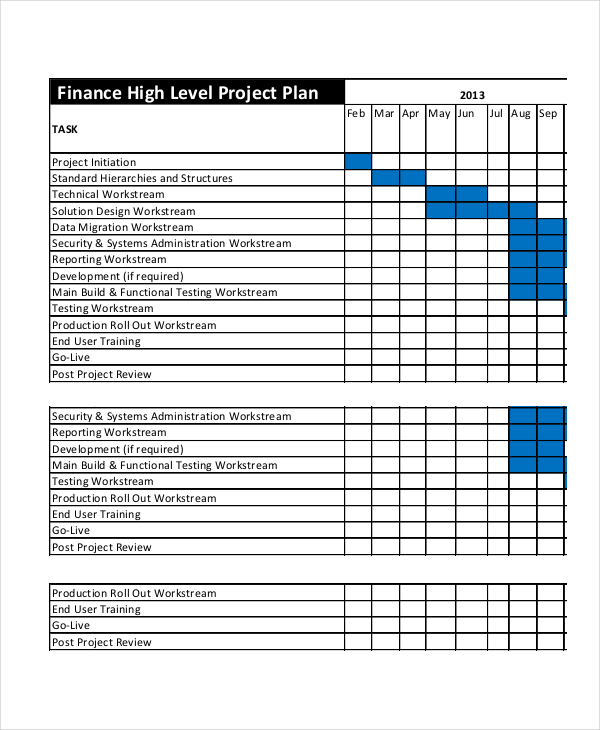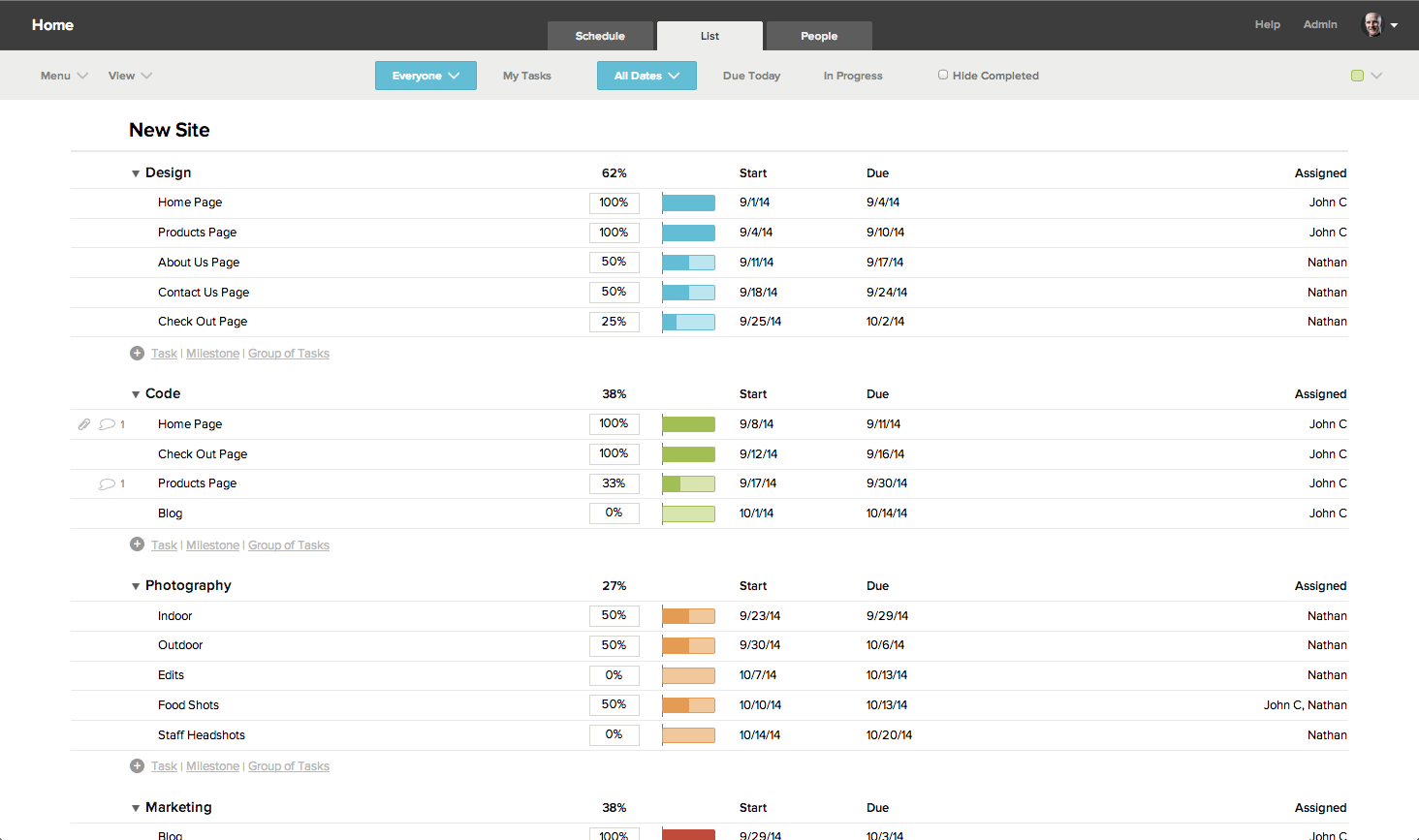고정 헤더 영역
상세 컨텐츠
본문


File Format. PDFSize: 192 KBWhat Is High-Level Project Planning?High-level planning means managing your project’s goals, dependencies, available resources, together with its timeline and budget. It states what should be done, when and by whom, without getting into details of particular tasks.
Project Plan Template Excel
It gives you a clear overview of the scope and required resources, so you can make informed decisions estimating and running your project. You may also see.High-level project planning is closely connected to Agile project management principles, which states that a project manager should oversee the process, which can be described as a facilitative way of leadership.
You may also see.In this case, facilitative leadership means that PMs point their teams in the right direction, ensure proper communication and project’s flow, at the same time allowing the team to take responsibility for the project themselves. File Format.
PDFSize: 64 KBHow to Implement a High-Level Plan?We’ve already discussed what a high-level project plan is and what it should consist of. Now, let’s evaluate how you can use it to schedule resources, estimate their costs, and manage your schedule.
Simple Project Plan Template Excel
You may also see.How to Allocate Resources and Estimate Their Cost?You need to evaluate your project’s objectives and the scope in order to decide whom to include in the project. Make use of a kick-off phase to better understand the project and the roles required to deliver it.When it comes to allocating your resources, the first thing to do is to align your employees’ skills and experience with your project’s requirements. Having already drafted a high-level project plan, you should already be familiar with your own goals and deliverables. All it takes now is for you to come up with a list of employees who meet the project’s criteria. You may also see.When allocating resources, remember to include not only what they are currently working on, or the future projects they have already been assigned to.
Make sure that you also have the following:. The employee’s availability, including their time zones and working hours. Are they working for you full-time, part-time, or are they freelancers?. Other work-related assignments. Day off and national holidays.This way, you lower the chances that some unexpected events interfere with your project over time. Once you’ve identified your team members and confirmed that they are available for the time of your project, estimate the budget with them using story points based estimation technique. By using high-level project planning, you will be able to identify resources that you need to deliver a project, confirm their availability, and estimate the project’s budget. You may also see.How to Manage Your Schedule Over Time?High-level planning is not just about the project’s start.
It’s also overseeing your project over time. One of the techniques you may want to use is resource leveling. It’s simply adjusting the workload to your employees’ availability in order to avoid overbooking.
What you need to watch out for, however, is that it changes the project’s path, resulting in delays in development.To distribute the slack more evenly, you can use resources smoothing technique which, according to PMBOK Guide, means adjusting “the activities of a schedule model such that the requirement for resources on the project does not exceed certain predefined resource limits.” You may also see.Using a schedule to monitor your team’s workload during the project allows you to spot how the availability of your team members changes. Then, you’ll be able to adjust their capacity and project scope, avoiding under or overbooking, which can lead to employee burnout. You may also see.High-Level Project Plan Point Template. File Format. PDFSize: 34 KBHow to Write a High-Level Project Plan in Five Simple StepsLearning how to develop a high-level project plan doesn’t need to be complicated. In fact, here are five easy steps on how to create one.Step #1.
Understand the scope and value of your project.At its core, a project plan defines your approach and the process your team will use to manage the project according to scope. Every project needs a plan. Not only does it go a long way toward keeping teams honest in terms of scope and deadlines, but a plan also communicates vital information to all project stakeholders.If you approach it as something more than a dry document and communicate that aspect of it differently to everyone involved, it can and will be seen as integral to your project’s success. The fact is that a plan is more than just mere dates. It’s the story of your project and you don’t want it to be a tell-tale.
Like every well-written story, there are components that make it good. You may also see.In fact, every solid plan should answer these questions:. What are the major deliverables?. How will we get to those deliverables and the deadline?.
Who is on the project team, and what role will they play in those deliverables?. When will the team meet the milestones, and when will the other members of the team play a role in contributing to or providing feedback on those deliverables?If your plan answers those questions and educates your team and clients on the project logistics, you’re creating a viable, strategic game plan for your project. Use those questions as a gut check after you’ve created your plan, and keep reading.Step #2. Conduct extensive research.Before you start creating a project plan, make sure that you know all the facts.
Take a deep breath, and then dive into the documents and communications relevant to the project. Print the scope of work and all details that come along with it, and read them end to end. You may also see.Be thorough. Understand the details and ask thoughtful questions before you commit to anything. A good project manager is well-informed and methodical in the way he or she decides to write a project plan.
At a minimum, you’ll be responsible for possessing a thorough understanding of the following: the goals of the project, your client’s needs and expectations, and the makeup of your client team and their decision-making process, such as their strategy in reviewing and approving of your team’s work, which might answer:. Who is the project sponsor, and how available is he?. Who is the PM, and will he plan on being in constant contact with you?. Who are the additional stakeholders your team should be aware of?Step #3.
Ask the tough questions.In addition to all of your questions about your client team and their expectations, set some time aside with your main client contact and ask them some tough questions about processes, organizational politics, and general risks before creating a project plan. You may also see.Doing so will not only convey that your team has the experience to handle any type of difficult personalities or situation, but it will also show that you care about the project and want it run smoothly, which is why you are gathering as much data as you can. You may also like.Here are some questions that may have an impact on a project plan:.
Has your team discussed how you will gather feedback?. Who is the final sign-off, or who owns the project?. Is there a stakeholder we need to consider who is not on your list? A president, a dean, or even the boss’s wife perhaps?. What is the project deadline? What are the factors of events that are calling for that date?
A meeting, an ad campaign, or maybe an event?. Are there any dates when you will be closed or unavailable?. Will there be any meetings or points in the project where you’ll want us to present on the current project status to a larger group, like in a board meeting?. Has your team been through a project like this in the past? How did it go?. Is there anything that would prevent the project from being successful?.
Is there a preferred mode of communication and online project planning tools?. Are there any points in the process that some stakeholders might not understand that we can explain?Step #4. Talk with your team.You must already know that project managers need to be in constant communication with their teams. Starting a project must begin with clear communication of the project goals and the effort required to meet them. This comes with understanding the fact that a project manager can’t be the only one writing the project plan. You may also see.It’s also great to utilize the super-smart folks surrounding you to get their input on how the team can complete the tasks at hand without killing the budget and the team’s morale. As a project manager, you need to know that the team can realistically execute the plan.You can also use your project plan review time to question your own thinking and push the team to take a new approach to the work.
For instance, if you’re working on a website design, can designers start creating visual concepts while the wireframes are being developed? Will it make sense for this project and for the team? Can you have two resources working on the same task at once?Running ideas by the team and having an open dialogue about the approach cannot only help you with building a project plan, but it’s also a big help in getting everyone to think about the project in the same terms. This type of buy-in and communication builds trust in a team and gets people excited about working together to solve a goal. It can work wonders for the greater good of your team and your project. You may also see.Step #5.
High Level Project Plan Template In Excel Free
Write your full project plan.When you’ve got all the info you need and you’ve spoken to all parties, you should feel more than comfortable enough to put together a rock solid high-level project plan using whatever tools work for you.High-Level Plan and Timeline. File Format. PDFSize: 58 KBMake it readable. There is no doubt that reading a project plan can be boring.
So, to avoid putting your audience to sleep instead of getting them excited about your work of art, use some formatting skills to make sure that tasks, durations, milestones, and dates are crystal clear. Try to make a simple project plan—the more straightforward and easier to read it is, the better. You should include these features:. All pertinent project information, such as the client’s name, the project’s name, the version number, and the delivery date. Break out milestones and deliverables in sections by creating headers and indenting subsequent tasks instead of letting your audience read on a long list of tasks, which can be monotonous and mind-numbing even to the best of us. You may also see.
Call out which team is responsible for each task. Add resources responsible for each task so there will be no confusion about who is responsible for what. Be sure to show durations of tasks clearly. Each task should have a start and an end date. Add notes to tasks that might seem confusing or need explanation.
It never hurts to add detail. Call out project dependencies. These are important when you’re planning for the risk of delays. Include your company’s logo and your client’s logo if you’re feeling fancy. Use your company’s branded fonts if you’re feeling really fancy. You may also like.In addition to all of this, you should be as flexible as possible when it comes to how your project plan is presented. There are no absolutes when it comes to how you represent your plan as long as you and your team understand what goes into one.
You may also like.Remember, people absorb information differently; while some people prefer a list-view, others might prefer to see a calendar or even a chart. You can make all of those variations work if you’ve taken the steps to create a solid plan. You may also check out.




